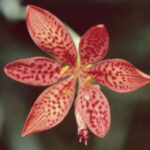Plant labels are very handy to remind you what you planted where, or to remind you of the name of a rose or shrub when a curious friend or neighbor asks. Also use plant labels to mark the location of spring bulbs that ‘disappear’ during the summer and fall as well as “disappearing” perennials like old fashioned bleeding heart or oriental poppies. Here are three of my favorite ways to make permanent plant labels, in order of ease to make and permanence
The Fast: Milk Jugs and Marks-a-Lot Plant Labels
With sharp scissors, cut a strip from the side of a milk jug, and write the name of the plant on it with a permanent marker like a Marksalot. Add any additional desired information including the date planted, source of seed or plant, it’s eventual height and spacing, etc, for better information for next year’s garden. Oh, and another source for your plastic strips is old mini-blinds. Simply cut to length and write away!
The upside: This is the cheapest, fastest and easiest way I know to make labels for what needs labeling. And of course, it works for more than plants. You can make bookmarks for your gardening or cook books as well. [Hint: Include the date and the subject you were thinking of at the time for your book mark!]
The downside: although better than simple paper and pencil, the permanent marker is not sun-proof. The writing will fade over the summer. Also, if you make a mistake writing it is impossible to correct. And if your handwriting is not the greatest or tends to be large, the markers will reflect that as well. But fast and cheap? You bet!
The compromise: If you are selling your plants at a farmers market or craft show and things need to look ‘pretty’ but not for very long, put the information you want on the label on your computer. Use a word processing program like Microsoft Word and then print it to Avery peel-and-stick labels (available at any office supply store like OfficeMax or Office Depot). The printing will be clearer, but they will not last nearly as long. Note that Microsoft actually as a template for this, for front and back of the labels here. These labels, on the mini-blind slats are very neat looking!
The Furious: Plastic and Pen Plant Labels
With a ball point pen (one that ‘rolls’), take those same milk jug strips and with a piece of cardboard under the plastic, press hard while you print the plant label information. It will ‘engrave’ the information into the material so no ink has to stay on the label.
To make them easier to see, put an old magazine cover under the plastic as you press down and it will transfer the colors from the magazine cover to the letters where you pressed. This will not last, but makes them easier to see for installing them.
The upside: This is much more permanent than using permanent marker, which will bleach out in the sunlight. The indenting will not ‘fade’ at all. Also, these can be made large enough to be attached two sided to a wire stake, stapled or simply pierced with the metal to hold them on.
The downside: there is no easy way to see what information is ‘engraved’ on the label in the bright sunlight, unless you wipe some dirt on the label to make some contrast. One other consideration: for some, the idea that they are plastic is an automatic downside. They are way too permanent in that they will not biodegrade for centuries if at all. And that is something to think about.
The Forever Label: Aluminum Can and Pointed Stick
These make a very permanent label, especially suited for your shrubs or rose bushes. And with an aluminum plant label attached with wire to your rosebush, you have a permanent answer to the admirer’s question “What’s the name of this rose?”
They are made the same way as the other plant labels, with the exception that they are cut from aluminum cans such as energy drinks, soft drinks or beer cans, instead of milk jugs. With sharp scissors, poke into the side of the aluminum can near the top, cut around to remove the top. Repeat to remove the bottom, leaving you a sheet of aluminum large enough for two or three labels, or more depending on how large a label you want to make.
My technique is to cut the long way of the aluminum, so I can fold over the engraved part of the plant label on itself, hiding the printing on the outside of the can. Before folding, use a pointed stick, or pen, and ‘engrave’ the plant label information as you did on the plastic. This can be done twice on the strip so that when folded, the information appears on both sides of the label.
Be careful of the sharp corners of the label. Once made, it might be good to cut round corners to make them less dangerous.
To attach the label to the plant, use a paper punch to make a hole in one end of the label and attach it to the plant (I am thinking rose bushes or shrubs here) with thin aluminum wire (the twist tie off a loaf of bread is another “free” source of materials). You now have a very permanent label for your shrub or rose.
Alternatively, you can attach them to wooden stakes using wire or staples and mark vegetable rows with them. If you want to take the time to paint them or color code them, they become even more valuable and permanent.
Conclusion
So there you have it, three fast and easy ways to label your plants in you garden, or to label you garden rows of seeds. And remember that this is also a great way to locate spring bulbs that ‘disappear’ during the summer and fall as well as “disappearing” perennials like old fashioned bleeding heart or oriental poppies.




